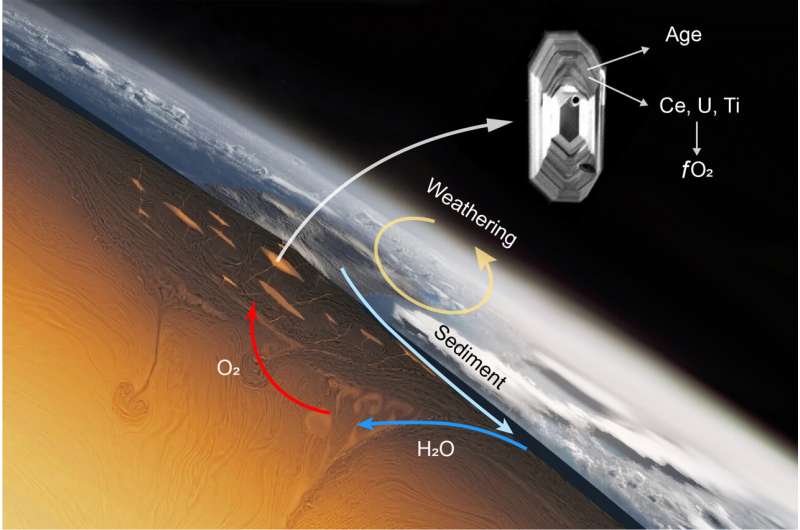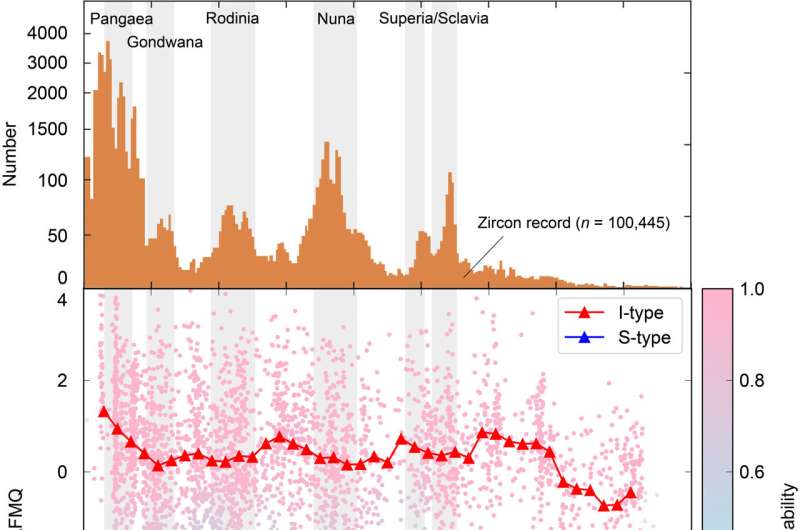This article has been reviewed according to Science X's editorial process and policies. Editors have highlighted the following attributes while ensuring the content's credibility:
fact-checked
trusted source
proofread
Zircons reveal the history of fluctuations in the oxidation state of crustal magmatism and the supercontinent cycle

Zircons, a mineral nearly as old as Earth itself, crystalize when magmas (molten rocks) cool and can be found in trace quantities in magmatic rocks. The formation of magma constitutes the mountains on the Earth. Through interactions with water and the atmosphere, the mountains break down into sediments.
Zircons are so durable and resistant to weathering and erosion that they rarely go away, and therefore, this mineral in sediments (so-called "detrital zircons") holds the greatest insight into the history of the Earth. Zircon enriches with U (U-Pb dating), is a timekeeper, and also provides a chemical window into many geological phenomena, such as oxidation state.
This understanding led to a study by Dr. Rui Wang and his Ph.D. student Shao-Chen Wu (Institute of Earth Sciences, China University of Geosciences, Beijing), Dr. Roberto Weinberg and Dr. Peter Cawood (Monash University), and Dr. William Collins (Curtin University).The study is published in the journal Science Bulletin.
The team uses a new method of Loucks et al. (2020) for determining the oxidation state of granitic magmas that uses ratios of Ce, U, and Ti in zircon to track the oxidation state change of crustal magmas through Earth's history. The calculation does not require an ionic charge to be known, nor is the determination of crystallization temperature, pressure, or parental melt composition required.

"Previous methods include Ce/Ce* and Eu/Eu* oxybarometers, but each has limitations related to temperature, pressure, host rock chemical compositional variations, or precision of REE elements needed to measure the Ce/Ce* and Eu/Eu* anomalies." Bob Loucks from Western Australia says.
This improved oxybarometer allows a more confident evaluation of the variation in oxidation state, which can now be interpreted in terms of global tectonic changes with time. By determining the oxidation levels of the magmas that formed these detrital zircons, scientists are able to deduce the onset of crust-to-mantle recycling, weathering, and the supercontinent cycle.
The key point is that rocks that lay at the Earth's surface can be carried back down to deep in the Earth's mantle (hundreds to thousands of km below the surface. Our data shows that not only is this happening today, but it could have been going on for billions of years.
Looking at zircons from the early Earth, 3-billion-year-old zircons, to those formed today, we have found the redox state of the magmas in which they formed. The oxidation state (expressed as ΔFMQ) of the detrital zircons rose at ~3.5 billion years, followed by a consistent average ΔFMQ > 0 over the last 3 billion years, suggesting recycling of oceanic lithosphere back into the mantle in what eventually became established as subduction zones.
It shows that the lower limit of the redox state dropped dramatically at 2.6 billion years ago, marking the formation of well-defined continents and the burial of oceanic rocks back into the deep mantle of the Earth. Further to that, we found a cyclicity of the redox patterns: every 600 million years or so, continents come together to form supercontinents, like Gondwana, Rodinia, Nura, and Superia.
More information: Rui Wang et al, Zircons reveal the history of fluctuations in oxidation state of crustal magmatism and supercontinent cycle, Science Bulletin (2023). DOI: 10.1016/j.scib.2023.10.034
Provided by Science China Press




















